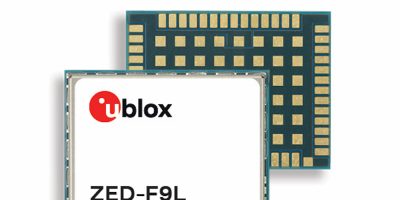The u-blox ZED-F9L is an L1/L5 GNSS receiver module, designed for automotive, telematics, V2X (vehicle to everything) and navigation applications.
It has integrated dead reckoning technology, six-axis IMU (inertial measurement unit), multiple outputs and robust automotive grade hardware (AEC-Q104) for automotive designs that demand top-tier performance and seamless integration, said u-blox.
The ZED-F9L leverages L1/L5 band signals and six satellite constellations simultaneously, including NavIC. The receiver provides continuous sub-meter-level positioning accuracy, using algorithms to combine GNSS measurements, IMU data, wheel ticks, and vehicle dynamics for positioning and attitude data, even when GNSS services are unavailable, u-blox added. The receiver also has a 50Hz output rate with low latency for real-time applications.
Operating temperature is up to 105 degrees C, for use in telematic control units (TCUs) under the roof or smart antennas and motorbike applications. Security features include anti-jamming and sensor-based anti-spoofing techniques.
The ZED-F9L module is pin-to-pin compatible with the ZED-F9K module, offering an upgrade path to RTK (real time kinetic) technology.
u-blox specialises in positioning and wireless communication in automotive, industrial, and consumer markets. The company’s products and services let people, vehicles, and machines determine their precise position and communicate wirelessly over cellular and short range networks. It offers a broad portfolio of chips, modules, and secure data services and connectivity for customers to develop innovative and reliable solutions for the IoT quickly and cost-effectively. The company has headquarters in Thalwil, Switzerland and offices in Europe, Asia, and the USA.







